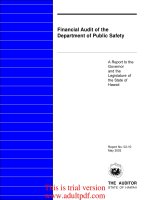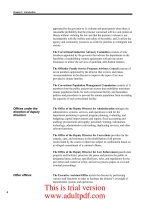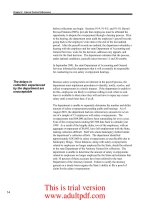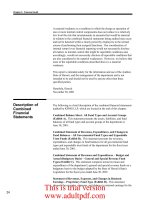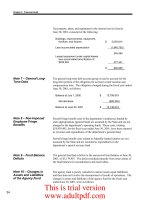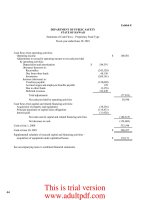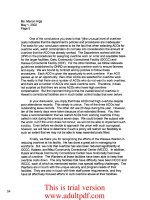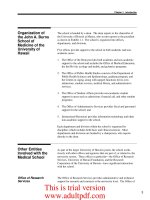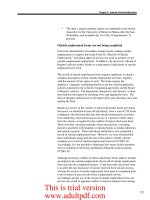Financial Audit of the Hawaiÿi Youth Correctional Facility A Report to the Governor and the Legislature of the State of Hawai‘i Report No. 07-01 January 2007 _part2 potx
Bạn đang xem bản rút gọn của tài liệu. Xem và tải ngay bản đầy đủ của tài liệu tại đây (180.99 KB, 10 trang )
5
Chapter 1: Introduction
Corrections Manager II
Corrections
Supervisor I*
Institutional
Facilities
Superintendent I **
Business Services
Supervisor II
Corrections
Program Specialist
I***
Account Clerk IV
Clerk Typists II
Clerk
Stenographers II
Stores Clerk II
Farm Manager I
Institution Food
Services Manager
Construct & Maint
Supervisor
Secretary III
Health Care
Services Section
Registered
Professional Nurse
V**
Reigsered
Professional Nurse
III
Registered
Professional Nurse
IIl
Dental Assistant III
Livestock Herders
Building
Maintenace
Workers II
Automotive
Mechanic II
Groundskeeper II
Custody Unit
Social Worker V
Youth Correction
Supervisors
Youth Correction
Officers
Social Workers
Corrections
Recreation
Specialists
Cooks III
NOTES
* On Special Assignment
** On Leave
*** Temporary-Position Being Held
Exhibit 1.2
Hawaiÿi Youth Correctional Facility
Organization Chart
Source: Office of Youth Services
This is trial version
www.adultpdf.com
6
Chapter 1: Introduction
concerted planning and programming, and they mainly warehoused
wards temporarily committed to their care.
Our audit also revealed that the Hawaiÿi Youth Correctional Facility fell
short in preparing its wards for return to the community. The facility was
largely deficient in the areas of basic and vocational education,
reintegration, and family involvement. The facility also lacked a health
education program and an infirmary. We concluded that a confusing and
uncertain central mission plagued the facility’s internal management.
In May 2006, our Management Audit of the Hawaiÿi Youth Correctional
Facility, Report No. 06-03, assessed the adequacy of the facility’s
management and organization. We found that the Office of Youth
Services has not provided the Hawaiÿi Youth Correctional Facility with
adequate guidance and support to carry out its mission. The Office of
Youth Services has not effectively implemented its strategic plan and has
not established a clear mission for the Hawaiÿi Youth Correctional
Facility.
We further found that the Hawaiÿi Youth Correctional Facility needs to
use productive management tools relating to human resource
management and quality assurance programs. The facility has left many
critical positions vacant or temporarily filled, conducted job performance
evaluations only sporadically, and has no formal or systematic training
program.
Exhibit 1.3
HMS 503 – Youth Residential Programs Budgets for
FY2004-05 and FY2005-06
Positions
FY2004-05 FY2005-06
General Fund Positions 88.50 88.50
Transfer Fund Positions .50 .50
Total Positions 89.00 89.00
Funds
FY2004-05 FY2005-06
General Fund $5,472,979 $6,278,187
Federal Funds 1,463,704 1,463,704
Transfer Funds 15,940 16,540
CIP Fund 0 100,000
Total Funds $6,952,623 $7,858,431
Source: Department of Human Services
This is trial version
www.adultpdf.com
7
Chapter 1: Introduction
1. Assess selected fiscal issues of the Office of Youth Services and
Hawaiÿi Youth Correctional Facility, including, but not limited to, a
review of sick leave, overtime, ward trust accounts, and procurement
issues.
2. Make recommendations as appropriate.
Our review focused on FY2004-05 to the present, but it included
previous fiscal years as necessary. We procured the services of a
certified public accounting firm (Grant Thornton LLP) to review
selected financial issues of the Hawaiÿi Youth Correctional Facility.
Specifically, the consultant reviewed the policies and procedures,
records, and internal controls in place at the Office of Youth Services and
the Hawaiÿi Youth Correctional Facility related to sick leave, overtime,
and procurement. In addition, the consultant interviewed personnel
involved in the management and oversight of the Hawaiÿi Youth
Correctional Facility and other relevant agencies.
Our work was performed from February 2006 to June 2006, and
conducted according to generally accepted government auditing
standards.
Objectives
Scope and
Methodology
This is trial version
www.adultpdf.com
8
Chapter 1: Introduction
This page intentionally left blank.
This is trial version
www.adultpdf.com
9
Chapter 2: HYCF Has Staffing and Internal Control Deficiencies
Chapter 2
HYCF Has Staffing and Internal Control
Deficiencies
Management ensures that organizational goals and objectives are met and
resources are safeguarded with the aid of internal controls. This chapter
presents our findings and recommendations on the financial accounting
and internal control practices and procedures of the Hawaiÿi Youth
Correctional Facility.
1. High vacancies drive significant overtime costs and sick leave usage.
2. Internal controls over the collection of salary overpayments could be
improved.
3. Controls over processing, disbursing, and reporting of wards’ trust
accounts should be strengthened.
4. Improved compliance with procurement laws and rules is needed.
The Hawaiÿi Youth Correctional Facility’s youth corrections officers
(YCOs) have incurred a significant amount of overtime and sick leave
during the fiscal year ended June 30, 2005. According to an analysis
prepared by the facility and submitted to the Legislature, the facility paid
out $818,231 in overtime to its 54 YCOs during FY2005. This
represents 52 percent of total base compensation for YCOs. These
individuals also accounted for 5,995 sick leave hours taken. The
stressful nature of the YCO position coupled with high vacancies
contributes to considerable overtime and sick leave costs for the facility.
However, because overtime and sick leave can be closely associated with
one another, the facility should be more proactive in monitoring both for
potential abuse.
In the facility overtime analysis, we judgmentally selected a sample of 20
YCOs and reviewed their payroll histories for FY2005. These YCOs
incurred total overtime pay of $406,425, which represents 35 percent of
their total gross compensation ($1,149,668) and 57 percent of their total
base compensation ($713,652). In fact, three out of the 20 YCOs tested
earned more in overtime than in base pay. One YCO earned $44,845 in
overtime compensation as compared to $36,494 in base pay.
Summary of
Findings
High Vacancies
Drive Significant
Overtime Costs
and Sick Leave
Usage
Overtime is a
significant but inherent
cost of the facility
This is trial version
www.adultpdf.com
10
Chapter 2: HYCF Has Staffing and Internal Control Deficiencies
Youth corrections officers fulfill a critical function at the facility by
maintaining care, custody, and control of juvenile wards. The position
works in a setting requiring 24 hours-a-day coverage. Overtime at the
facility is incurred when a YCO calls in sick and the youth corrections
supervisor on duty must find a replacement. Youth corrections officers
who are not scheduled to work on that respective day are offered the
opportunity for overtime through a system that benefits officers with the
most seniority. All overtime is approved by either the corrections
supervisor I or the youth facility administrator on Form D-55 “State of
Hawaiÿi Individual Timesheet.”
We were informed by facility personnel that one cause of the significant
amount of overtime is the high YCO vacancy level at the facility. Based
on the facility’s payroll records, we found that as of June 30, 2005, 18
out of 70 available positions were either vacant or filled by temporary
employees; there were 11 vacancies and seven positions that were filled
by 89-day emergency hires. Overtime is also driven by the amount of
sick leave taken by YCOs. Due to the critical nature of the function, if
an YCO unexpectedly calls in sick, a replacement will have to be asked
to work overtime to cover.
Difficulty in filling and maintaining adequate staffing levels for YCOs,
coupled with the stressful nature of the work, contribute to the significant
amounts of overtime incurred by the facility’s YCOs. This condition
could lend itself to higher levels of employee stress and turnover. The
high level of overtime could also lead to sick leave abuse, which is
defined as taking sick leave when not actually sick.
In order to assess YCO sick leave usage we considered the same 20
YCOs selected for overtime analysis; however, we noted only 17 of these
YCOs had been employed at the facility for the entire year and limited
our review to these individuals. For these 17 YCOs, we reviewed the
payroll registers noting that they took a total of 2,787 hours of sick leave,
which amounts to an average of 164 hours per officer. Generally, state
employees earn 168 hours, or 21 days, of sick leave per year. However,
we found that 12 of the 17 YCOs tested took 168 hours or more of sick
leave during FY2005. In addition, these 12 YCOs also took an aggregate
of 2,809 hours of compensatory time off in lieu of sick leave which
averages out to 234 hours per officer. One YCO took 168 hours of sick
leave and 481 hours of compensatory time off in lieu of sick leave, for an
aggregate of 649 hours.
Youth corrections officers are required to call the youth corrections
supervisor on duty for their section and inform them that they will be on
sick leave for that respective day. The YCOs are required to complete
Form G-1 “State of Hawaiÿi – Application for Leave of Absence” within
Youth corrections
officers incur a
significant amount of
sick leave
This is trial version
www.adultpdf.com
11
Chapter 2: HYCF Has Staffing and Internal Control Deficiencies
five days after they return to work. After each pay period, a clerk
stenographer at the facility updates YCO leave records based on an
attendance report, which is a summary of daily attendance records by pay
period. If the clerk stenographer finds that a YCO has exhausted all sick
leave hours, she informs the YCO via memorandum that there is
insufficient sick leave and what type of leave may be elected in lieu of
sick leave, including available compensatory time and vacation. If the
officer’s Form G-1 has already been approved, the clerk stenographer
whites out the authorized signatures and sends the Form G-1 back to the
YCO for revision and approval.
Youth corrections officers are responsible for contacting their section
supervisors when taking sick leave. The supervisors do not have the
YCOs’ leave records available when taking the call to determine if the
YCO has adequate sick leave.
Although the facility’s procedures for approval of overtime and sick
leave appear adequate, the facility does not have a system for
simultaneously monitoring both for potential abuse. Facility
management does not periodically compare overtime and sick leave
records to determine patterns which signal misuse. Such a review is
important due to the close relationship between the two factors and the
resulting expenses. Not only do significant overtime and sick leave lead
to higher levels of stress and employee turnover, they directly drive each
other. Facility personnel have indicated that they sometimes take sick
leave because they “need a break” from all the overtime. The facility
must take the initiative in controlling these significant costs and stressful
situations.
We recommend that the facility develop and implement a formal system
of monitoring overtime and sick leave usage among all employees. This
system should designate a management level employee to review
timesheets in conjunction with leave records on a monthly basis for
situations indicative of overtime and sick leave abuse. The system
should define these situations, which could include periods of extensive
overtime followed by sick leave. Once employees have displayed any of
these patterns they should be placed in a program of more thorough
review. This would also allow the facility to identify and alleviate
excessively stressful situations for its employees.
We further recommend that the facility work with the Office of Youth
Services to fill YCO vacancies as soon as possible. We also recommend
that a management level employee be designated to assess whether
overtime is in fact necessary in situations when a YCO calls in sick.
The facility should
monitor overtime and
sick leave concurrently
Recommendation
This is trial version
www.adultpdf.com
12
Chapter 2: HYCF Has Staffing and Internal Control Deficiencies
Lastly, we recommend that the facility determine whether YCOs’ leave
records can be made available to section supervisors during their shifts to
determine if adequate sick leave is available to an officer who calls in
sick.
The Hawaiÿi Youth Correctional Facility does not employ monitoring
controls in the collection of salary overpayments. Salary overpayments
arise when employees are paid for days they are absent from work but
have no sick leave, compensatory time, or vacation leave to account for
the time off. A clerk stenographer maintains employee leave records,
and additionally processes documents sent to the payroll section which
adjust employees’ current or subsequent payroll for any leave without
pay. The clerk stenographer maintains a file of all documents sent to
payroll; however, there is no process to ensure that collections were
processed correctly and timely by the payroll section. Further, payroll
adjustment records are maintained in the payroll section.
A proper system of internal controls should include monitoring functions
such as maintaining detailed records of salary overpayments incurred and
collected, reviewing the collections processed by the payroll section, and
reviewing the “State of Hawaiÿi Payroll Assignment Register” for facility
employees with overpayment balances from prior years. Although no
significant discrepancies were found during our testing, the current
process does not ensure that amounts collected for salary overpayments
are proper or collected in timely fashion.
During our testwork we noted the following data related to salary
overpayments:
• During FY2005, five youth corrections officers incurred
overpayments resulting from sick leave in 18 pay periods
aggregating $7,588. We reviewed nine repayments and noted
that they were processed in the subsequent pay periods. As of
July 20, 2005, all overpayments were repaid.
• At the beginning of FY2005, nine employees had overpayment
balances totaling $16,631, which were being repaid through
payroll withholdings pursuant to agreements with the
Department of Human Services. At the end of the fiscal year,
two youth corrections officers had overpayment balances totaling
$3,608.
• We found one instance where $148 was over-collected from a
youth corrections officer.
Internal Controls
Over the
Collection of
Salary
Overpayments
Could Be
Improved
This is trial version
www.adultpdf.com
13
Chapter 2: HYCF Has Staffing and Internal Control Deficiencies
We recommend that the facility implement monitoring controls over the
collection of salary overpayments, including maintaining detailed records
of salary overpayments incurred and collected. We also recommend that
a management level employee be designated to perform the following:
• Review the detailed records of salary overpayments incurred and
collected to monitor the extent and status of the overpayments.
• Review the collections processed by the payroll section to ensure
accuracy and timeliness.
• Review the “State of Hawaiÿi Payroll Assignment Register” for
facility employees with overpayment balances from prior years
to monitor the extent of the balances and to ensure they are
collected timely.
During our review of facility procedures over wards’ trust accounts, we
noted a lack of segregation of duties over the processing and
recordkeeping of transactions in the wards’ trust accounts and a
weakness in the controls over disbursements from the wards’ trust
accounts. We also noted noncompliance with the facility policy in
providing wards with monthly statements of their transactions. Although
the balances in the wards' trust accounts are immaterial to the facility (24
trust accounts totaling $656 as of June 30, 2005), they can be very
significant to the respective wards.
There is a lack of segregation of duties over the processing and
recordkeeping of transactions in the wards’ trust accounts. The facility
account clerk records wards’ trust account transactions in the accounting
system, reconciles the bank statement, and prepares and distributes
checks for disbursements from the accounts. The account clerk also has
access to the safe in which documents and cash are stored until they are
deposited. In addition, a review of the bank reconciliation by a person
not otherwise involved in the processing of wards’ funds is not
performed.
Segregation of duties is one of the most important principles of internal
accounting control. No one person should be responsible for the
recording and processing of a transaction. In addition, an independent
review of the bank reconciliation is one of the basic tenets of internal
control over cash. The potential effect is that the lack of segregation of
duties does not provide an adequate safeguard over the wards’ funds.
Recommendation
Controls Over
Processing,
Disbursing, and
Reporting of
Wards’ Trust
Accounts Should
Be Strengthened
Processing and
recording duties for
wards’ trust account
transactions are not
properly segregated
This is trial version
www.adultpdf.com
14
Chapter 2: HYCF Has Staffing and Internal Control Deficiencies
The cause of the problem is a lack of consideration or understanding of
the basic principles of internal control at the facility.
Withdrawals from trust accounts are initiated by the ward’s authorized
requisitioner who is required to complete Form YCF #87 “HYCF
Request Withdrawal of Funds from Ward’s Trust Fund.” After approval
by the facility section administrator, the form is submitted to the account
clerk who prepares the check after first determining that the ward has
sufficient funds. We were informed that check signers are not provided
Form YCF #87 and other supporting documents when signing the check,
except upon request. One of the basic tenets of internal control over cash
disbursements is that check signers review and initial the supporting
documents to show proof of their review when signing checks.
Because check signers are not consistently reviewing the supporting
documents when signing checks, there is increased risk of unauthorized
withdrawals being made from the wards’ trust accounts.
We discovered that wards are not regularly presented with a monthly
statement of the transactions relating to their accounts. While the
account clerk prepares a monthly statement of the activity of each ward’s
account, a copy of the statement is not provided to the ward except upon
request. Hawaiÿi Youth Correctional Facility Policy #1.02.53 “Trust
Account,”Section 4.4 “Procedures,” indicates that “the Account Clerk
shall maintain individual ledger accounts for each committed person and
shall issue a monthly statement showing deposit amounts, withdrawal
amounts, dates of transactions, and trust account balances to each
committed person via their respective Social Workers.”
The monthly trust account statements are given to each ward’s social
worker; however, no monitoring controls over the distribution of
statements to the wards are in place, including oversight by a
management level employee to ensure the wards receive their monthly
statements from their social workers. Without such receipt, wards are
unaware of the activity in their account and thus could not dispute
potential errors.
We recommend that:
• A review over the internal controls over wards’ funds be
conducted to address the lack of segregation of duties.
Consideration should be given to utilizing personnel from the
Office of Youth Services to assist in the review of monthly bank
reconciliations. In addition, the review should be documented
with the reviewer’s initials.
No review of
supporting documents
when signing for
wards’ checks
Wards may not be
given an opportunity to
review their account
statements
Recommendations
This is trial version
www.adultpdf.com
